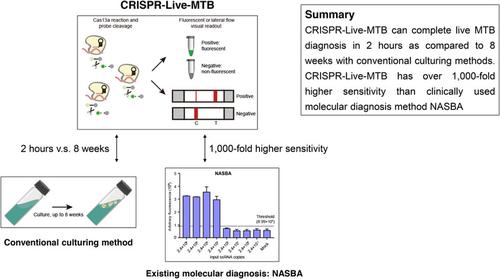Rapid and sensitive diagnosis of live Mycobacterium tuberculosis using clustered regularly interspaced short palindromic repeat‐Cas13a point‐of‐care RNA testing
IF 11.3
1区 化学
Q1 CHEMISTRY, PHYSICAL
引用次数: 0
Abstract
Mycobacterium tuberculosis (MTB) is the causal pathogen of tuberculosis (TB). Rapid and accurate detection of live MTB is important for transmission control and patient treatment. Here, we described a clustered regularly interspaced short palindromic repeat (CRISPR)‐Cas13a‐based molecular diagnosis approach for rapid and specific detection of live MTB. This detection method, which we termed CRISPR‐Live‐MTB, contained two consecutive reactions including nuclear acid sequence‐based amplification (NASBA) and CRISPR‐Cas13a collateral cleavage reaction. CRISPR‐Live‐MTB could efficiently detect MTB single‐stranded RNA (ssRNA) in 2 hours with high specificity over double‐stranded DNA (dsDNA). Importantly, CRISPR‐Live‐MTB exhibited a limit of detection of 2.4 copies for MTB ssRNA, which was 1000 times lower than that of the clinically used NASBA method. Moreover, lateral flow was integrated into the CRISPR‐Live‐MTB method to enable point‐of‐care testing application with a sensitivity of 95% and a specificity of 100%. Overall, our study demonstrated the feasibility of CRISPR‐Live‐MTB as a rapid, sensitive, and specific approach for live MTB detection.

利用聚类规律性间隔短回文重复-Cas13a 床旁 RNA 检测快速灵敏地诊断活结核分枝杆菌
结核分枝杆菌(MTB)是结核病(TB)的病原体。快速准确地检测出活的 MTB 对控制传播和治疗病人非常重要。在此,我们介绍了一种基于聚类规则间隔短回文重复(CRISPR)-Cas13a的分子诊断方法,用于快速、特异性地检测活的MTB。我们将这种检测方法称为CRISPR-Live-MTB,它包含两个连续反应,包括基于核酸序列的扩增(NASBA)和CRISPR-Cas13a附带裂解反应。CRISPR-Live-MTB可在2小时内高效检测MTB单链RNA(ssRNA),对双链DNA(dsDNA)具有高度特异性。重要的是,CRISPR-Live-MTB 对 MTB ssRNA 的检测限为 2.4 个拷贝,比临床使用的 NASBA 方法低 1000 倍。此外,CRISPR-Live-MTB 方法还集成了横向流动技术,可用于床旁检测,灵敏度达 95%,特异性达 100%。总之,我们的研究证明了 CRISPR-Live-MTB 作为一种快速、灵敏、特异的活 MTB 检测方法的可行性。
本文章由计算机程序翻译,如有差异,请以英文原文为准。
求助全文
约1分钟内获得全文
求助全文
来源期刊

ACS Catalysis
CHEMISTRY, PHYSICAL-
CiteScore
20.80
自引率
6.20%
发文量
1253
审稿时长
1.5 months
期刊介绍:
ACS Catalysis is an esteemed journal that publishes original research in the fields of heterogeneous catalysis, molecular catalysis, and biocatalysis. It offers broad coverage across diverse areas such as life sciences, organometallics and synthesis, photochemistry and electrochemistry, drug discovery and synthesis, materials science, environmental protection, polymer discovery and synthesis, and energy and fuels.
The scope of the journal is to showcase innovative work in various aspects of catalysis. This includes new reactions and novel synthetic approaches utilizing known catalysts, the discovery or modification of new catalysts, elucidation of catalytic mechanisms through cutting-edge investigations, practical enhancements of existing processes, as well as conceptual advances in the field. Contributions to ACS Catalysis can encompass both experimental and theoretical research focused on catalytic molecules, macromolecules, and materials that exhibit catalytic turnover.
 求助内容:
求助内容: 应助结果提醒方式:
应助结果提醒方式:


